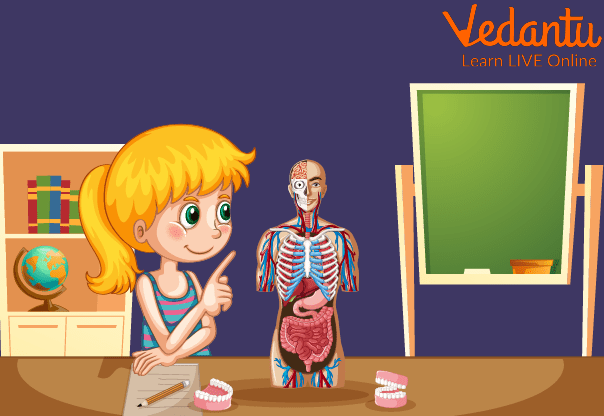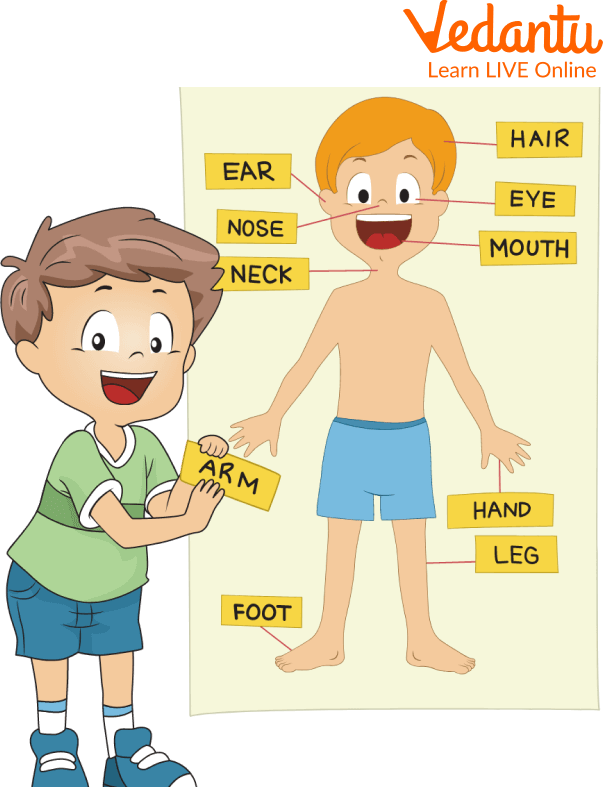




An Overview of Human Body for Kids
The organs, muscles, nerves, and bones work hard under your body's skin. Because of them, you are alive and healthy without even realising it. But don't you have a question about how these body systems work? You might know about the head, shoulders, knees, and toes, but are there other important body parts present? So let's study them also in this article.
The body system is an organisation of varying numbers and types of organs so arranged that together they can perform different functions for the body and keep us alive. Examples are the digestive system, excretory system, etc.
Keep reading this article to learn about the body system for the kid, the human body for kids, and parts of the body for kids.
Parts of the Body for Kids
Let's discuss about all the body parts one by one.
1. Parts of the Arms
Every part of the arm has a particular function to perform. Some of its parts help with bending, and others help with experiencing the sense of touch. And the most important part that differentiates humans from most other animals: is the opposable thumb!
2. Parts of the Legs
The list of body parts divides the legs into different sections according to their location and function—The knee comes under the parts of the leg.
3. Parts of the Torso
Have you heard about “strengthening your core,” but what does it mean? The core is the middle portion of the body, where the arms and legs branch off. These are the external parts of the core of the body.

Kids Observing the Internal Body Parts.
External Human Body Parts for Kids
The external human body parts for kids contain skin, hair, and nails. The external parts of the head include the eye, ear, nose, mouth, tongue, and teeth. The limbs include the arm and leg, and how to forget the hand, foot, and knee. The bones and muscles are holding up the body and making moving possible.
Human Body Systems
The human body parts for kids contain the following systems of the body. Healthy body functions are not possible without these systems.
1. Nervous system
The two main parts of the nervous system are the central and peripheral nervous systems. Due to the nervous system, all the organs present in the human body can communicate with each other.
2. Circulatory System
The circulatory system is responsible for carrying nutrients all around the body. One of the most important functions of this system is to bring oxygen from the lungs to the other body cells. Also, the system helps to provide nutrients and hormones to muscles, tissues, and other organs throughout the body.
3. Digestive System
The digestion of food is important to distribute nutrients and other vital elements. When the food is chewed, it undergoes a process called digestion. The process of digestion begins at the mouth and ends at the anus. This system plays a vital role in the breakdown of food into protein, carbohydrates, and nutrients.
4. The Urinary System
Not all waste materials are excreted through the digestive system, so the urinary system balances the body by eliminating the waste through urine. This system is also known as the renal system. Due to this system, the liquid waste is thrown out of the body.
5. The Respiratory System
A body can't function without oxygen. The respiratory system takes oxygen through respiration. The respiration process is known as breathing. During breathing, your body takes oxygen in and expels carbon dioxide from the body. We can breathe with the help of this system. This system purifies the air that we breathe.
6. Skeletal System
The skeletal system provides support to the vital organs. This system gives structure to the body. The skeletal system includes 206 bones, including connective tissue such as tendons, ligaments, and cartilage. This system provides the structure and shape of the body.
7. Muscular System
The muscular system helps the body move. When the brain sends any kind of signal to a muscle in the body, the neurotransmitters tell the muscle what to do. This important function this system plays is to allow us for any kind of movement.

Different Body Parts
Summary
The human body is made up of different parts. The study of these body parts is known as anatomy. Every part of the body has a particular function to do. The study of body functions is known as physiology. The healthy working of the body is possible due to the system inside it. These systems include the digestive system, nervous system, skeletal system, etc. The external parts of our head are the eyes, ears, nose, cheeks, and lips. A proper diet can keep our body and body parts healthy and safe. The system of the body that prevents humans from being attacked by bacteria is known as the immune system. In this article, we have covered external human body parts for kids.
FAQs on Body System for Kids
1. What is a body system in simple terms?
Think of your body as a big, busy team. A body system is a special group of organs that work together to do an important job. For example, your digestive system works to get energy from food, while your skeletal system gives your body its shape and strength.
2. What are the main body systems kids should know about?
For kids, it's great to start with five major systems. Each has a special role:
- Skeletal System: This is your body's frame, made of all your bones. It gives you shape and protects your soft organs inside.
- Muscular System: These are the muscles that help you run, jump, lift things, and even smile.
- Digestive System: This system takes the food you eat and turns it into energy for your body to use.
- Respiratory System: This system, which includes your lungs, helps you breathe in fresh oxygen and breathe out old air.
- Circulatory System: Led by the heart, this system pumps blood to carry oxygen and nutrients to every single part of your body.
3. How do all the different body systems work together like a team?
Our body systems are excellent teammates! For example, when you run to catch a ball, your muscular system helps you move your legs. Your respiratory system breathes faster to get more oxygen. Then, your circulatory system rushes that oxygen through your blood to your muscles so they can keep working. They all cooperate perfectly to help you play!
4. Why is learning about body systems important?
Understanding your body systems helps you know how to stay healthy. When you learn that the digestive system needs healthy food for energy or that the muscular system needs exercise to be strong, you can make better choices for your body every day. It’s like having an instruction manual for yourself!
5. Which is the largest organ in our body?
The largest organ in the human body is the skin. It acts like a protective shield that covers everything inside your body. It also helps you feel things like hot and cold and plays a big role in controlling your body's temperature.
6. How many bones does an adult have in their skeletal system?
An adult human has 206 bones that make up their skeletal system. Interestingly, babies are born with around 300 bones, but some of these bones fuse together as they grow older to form the stronger, 206-bone skeleton.
7. Can an organ be a part of more than one system?
Yes, some amazing organs do double duty! For example, the pancreas is a key part of the digestive system because it makes enzymes to break down food. It's also part of the endocrine system because it produces important hormones like insulin that control blood sugar.









